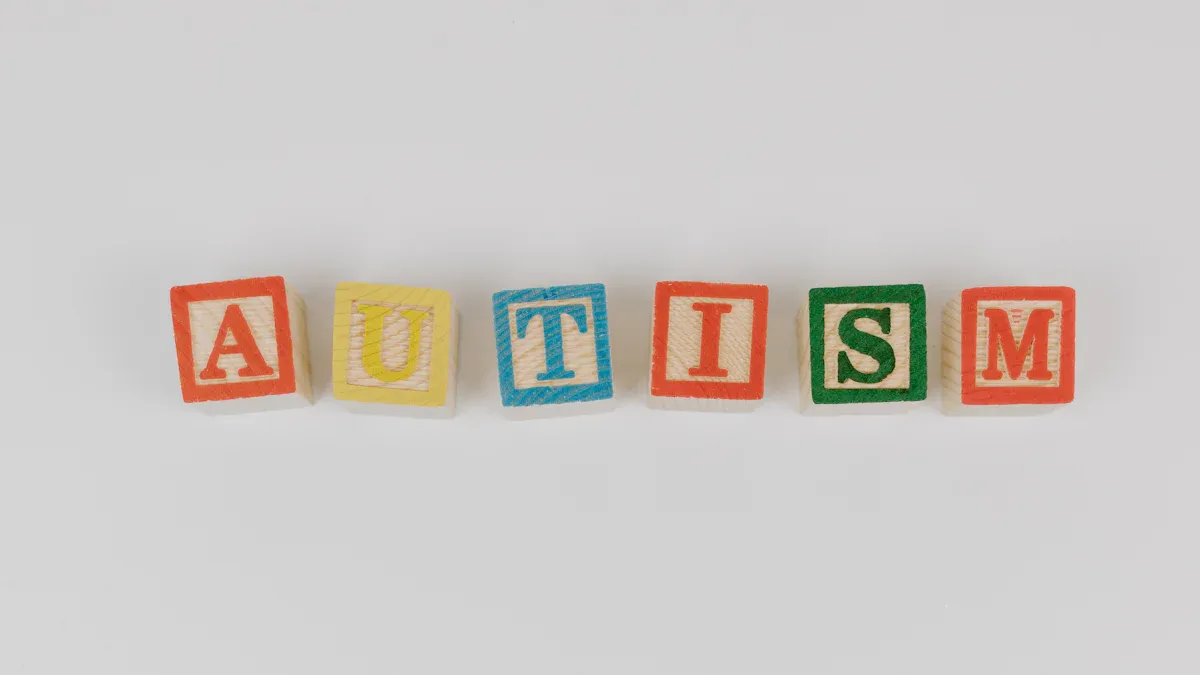What Is Sensory Overload in Autism and How Does It Show Up

Sensory overload autism refers to experiencing intense reactions to sounds, lights, smells, or touch, which is common among people with autism. Many individuals with sensory overload autism feel overwhelmed by everyday sensory input. In fact:
Studies indicate that 90% to 98% of autistic children experience sensory overload autism and related sensory issues.
The National Institute of Mental Health reports that over 90% of children with autism face sensory overload autism challenges.
Sensory overload autism often occurs because the brain processes sensory information in a heightened way, leading to strong emotional or behavioral responses, especially when the environment becomes overwhelming.
Key Takeaways
Sensory overload happens a lot in autism. It affects almost all autistic kids. It happens when the brain gets too much sensory input at once. The brain cannot handle all the information.
Noticing signs of sensory overload is important. Some signs are covering ears or feeling worried. This helps you know when someone has sensory overload. You can help and support them better.
Finding out what causes sensory overload is helpful. Loud sounds or bright lights can be triggers. Knowing these triggers helps people get ready. They can handle sensory overload better.
Making a sensory-friendly space is useful. Use soft lights and calming items. This can lower the chance of sensory overload.
Self-care can help with sensory overload. People can use noise-canceling headphones. They can also try mindfulness. These things make daily life easier.
Understanding Sensory Overload Autism

What Is Sensory Overload
Sensory overload means your senses get too much information at once. In autism, this happens when the brain cannot handle all the sounds, lights, or smells around you. Some people with autism react a lot to loud noises or bright lights. Others might not notice these things much.
Sensory overload, also called overstimulation, happens when your brain gets more input than it can handle. This can make daily life hard, like making it tough to talk to others or join in activities.
Here is a table that shows how sensory overload works in autism:
Mechanism | Description |
|---|---|
Atypical Neural Responses | The brain may react differently to things you see or hear, making you more sensitive. |
Weakened Habituation | It can be hard to get used to repeated sounds or sights, so they keep bothering you. |
Brain Regions Involved | Parts of the brain, like the amygdala and sensory cortices, help process what you sense. |
Sensory overload can mean you feel too much (hypersensitivity) or not enough (hyposensitivity). Both can make everyday life harder.
Why It Happens in Autism
You might ask why sensory overload is common in autism. It is because the brain processes information in a different way. If you have autism, you may notice sounds or touches more than others do. Studies say about 70% of kids with autism have trouble with sensory processing, which can cause sensory overload.
New research using brain scans shows that kids with autism have differences in brain areas that handle senses. These differences make it hard to ignore background noise or bright lights. People without autism can get used to new sounds or sights fast, but you might keep noticing them, which can feel like too much.
Knowing about sensory overload in autism helps explain why some people avoid crowds or wear headphones in noisy places. Learning about these brain differences can help you support yourself or others who deal with sensory overload autism.
Signs and Symptoms of Sensory Overload in Autism
It is important to know the signs of sensory overload in autism. This helps you understand what you or someone else might go through. These signs can show up in your body, feelings, or actions. If you know how sensory overload looks, you can find ways to help. You can also make places more comfortable for people with sensory issues.
Physical Signs
Physical signs can happen very quickly. You might see these changes when things get too busy or loud. Some common signs are:
Putting your hands over your ears when noises are loud or sudden
Covering your eyes if lights are too bright or there is too much to look at
Staying away from things that feel or smell bad
Moving your hands or body to calm yourself down
Making your hands into fists or tightening your muscles
Walking back and forth or moving in the same way again and again
Trying to leave a place that feels too much
You might also feel sick or uncomfortable, like:
Feeling sick to your stomach
Noticing your heart beats faster or your breathing changes
For example, busy places can be hard because of loud sounds and lots of movement. You might cover your ears or want to find a quiet spot. Some clothes or tags can bother you, so you might not want to wear them.
Emotional and Behavioral Signs
Sensory overload does not just affect your body. It also changes how you feel and act. You might feel upset, worried, or annoyed if you cannot block out extra sounds or sights. Some signs are:
Your mood or actions change suddenly
You feel more worried or get annoyed easily
You might have a meltdown, which means you cry, yell, or act out
You do not want to be around other people or talk to them
It is hard to pay attention or finish things
You move a lot, like flapping your hands or jumping
You look for strong feelings, like spinning or rocking, to feel better
Sensory overload can make daily life tough. You might not want to go to school or events. Even easy things can feel hard. You might have a meltdown or shut down if you feel too much. This can make it hard to talk or answer people.
Sensory Overload in Autistic Adults
Sensory overload in adults with autism can look different than in kids. Adults may try to hide how they feel, but the signs are still there. You might see:
Crying a lot and not being able to stop
Yelling or talking louder because you feel upset or scared
Suddenly feeling scared or overwhelmed by feelings
Getting annoyed or angry very quickly
Not wanting to talk, even to people you know well
Leaving a room fast or becoming very quiet
Throwing or pushing things if you feel too stressed
Not being able to follow directions or answer questions
Adults with sensory overload autism might also shut down. This means you cannot talk or move for a while. You may need to find a quiet place to feel better. People with autism can have trouble blocking out sounds or sights, which can cause strong reactions.
Many autistic people learn ways to cope as they get older, but sensory problems can still happen. You might stay away from some places or things to avoid overload. Knowing the signs in adults helps you get help and use ways to feel better.
Triggers of Sensory Overload

Knowing what causes sensory overload in autism helps you get ready. Triggers can come from around you or from inside your mind or body. If you know your triggers, you can try to avoid them or handle them better.
Environmental Triggers
Many people with sensory overload autism react to things around them. Places you go every day might have loud sounds, bright lights, or strong smells. Cities often have lots of noise and dirty air. These things can make you feel more anxious or change how you act. Busy streets, crowded malls, or even classrooms can cause sensory overload in autism.
Here is a table that lists common environmental triggers:
Type of Trigger | Examples |
|---|---|
Sounds | Loud noises, music, sirens |
Lights | Bright or flickering lights |
Textures | Certain fabrics, food consistency |
Smells | Strong perfumes, food odors |
Tastes | Textures and flavors in food |
Body Movements | Crowds, swinging, or rocking motions |
Even small changes in your surroundings can cause sensory processing disorder symptoms. Sensory overload can make it hard to pay attention or stay calm.
Social and Internal Triggers
Some triggers do not come from outside. They start inside your body or mind. These triggers can be just as strong as things in your environment.
Anxiety can get worse if you are sensitive to senses. This can make you feel upset or lead to meltdowns.
Feeling tired makes it harder for your brain to handle senses, so you get overwhelmed faster.
Stress from emotions, like being sad or worried, can make sensory overload worse.
Being around lots of people or talking in groups can cause sensory overload in autism.
Learning new things quickly or feeling strong emotions can also be triggers.
When you face these triggers, you might feel sensory overload right away. You may want to leave a room or stop talking. Sensory processing disorder can make these times even harder.
Tip: If you know your triggers, you can take breaks or use calming tools to help with sensory overload.
Coping with Sensory Overload in Autism
Prevention Strategies
You can stop sensory overload by changing your routine and space. Make your home or school more sensory-friendly. Use LED lights that you can adjust. This keeps the room bright but not too bright. Avoid lights that flicker because they can bother you. Sunlight can help you feel calm and happy. Bubble tubes or projectors show relaxing pictures. Soft lights are better than harsh ones, which can make you feel bad.
Here are some ways to stop sensory overload:
Use things like stress balls or weighted blankets to help you feel calm.
Wear sunglasses or look at one thing to block out too much to see.
Try grounding tricks, like the 5-4-3-2-1 method, to stay focused.
Take breaks in busy places so you do not get overwhelmed.
Make a kit with earplugs, fidget toys, and sunglasses.
Change your space by using dim lights and quiet rooms.
Use apps to control sounds around you.
Tell people what you need so they can help you.
Tip: These changes can help you handle sensory problems and stop unwanted actions.
Self-Care and Support
Dealing with sensory overload means caring for yourself and asking for help. Use headphones that block noise, weighted blankets, or fidget toys. Mindfulness, like deep breathing or meditation, can help you relax. Grounding and writing in a journal help you understand your feelings. Drawing or listening to music can lower stress.
You can use personal care items and light filters that are good for your senses. Be ready for changes by having flexible plans and checking how you feel. Talk to family and friends for support. Family and caregivers help you manage sensory overload. They learn your triggers and help make your space better. Occupational therapy and sensory diets give extra help if you need it.
Note: Having strong bonds with family and caregivers helps you feel safe. Getting help from professionals teaches you ways to cope and makes life better.
Sensory overload in autism happens when your brain gets too much input. This can come from things you see, hear, or touch. You might feel nervous or find it hard to pay attention. Sometimes, you may want to leave places that are loud or crowded. If you notice these signs early, you and your helpers can make things calmer and safer.
Use sensory tools like headphones that block noise or heavy blankets.
Change the lights and find quiet spots when you need a break.
Share what you need and use pictures to help make changes.
You are not alone in this. Family, therapy, and good resources can help you feel better.
FAQ
What should you do if you feel sensory overload coming on?
You can take a break in a quiet place. Use headphones or sunglasses if you need them. Tell someone you trust how you feel. Try deep breathing or use a fidget tool to help calm down.
Can sensory overload happen even in familiar places?
Yes, sensory overload can happen anywhere. Even at home or school, new sounds, smells, or changes in routine can trigger it. You might feel overwhelmed even in places you know well.
How can you help a friend with sensory overload?
Stay calm and speak softly. Offer them a quiet space or ask if they want help. Do not touch them unless they say it is okay. Let them use their coping tools.
Is sensory overload the same for everyone with autism?
No, sensory overload looks different for each person. Some people react to loud sounds, while others notice bright lights or strong smells. You might have different triggers than someone else.
Can you prevent sensory overload completely?
You cannot always prevent sensory overload. You can lower your risk by knowing your triggers and using coping strategies. Planning ahead and making your space comfortable helps you feel safer.
See Also
Exploring Support Strategies for Autism Sensory Overload
Effective Therapies to Address Sensory Challenges in Autism
Benefits of Sensory Rooms for Children on the Autism Spectrum
An In-Depth Look at Sensory Processing for Autism
Innovative Sensory Board Concepts to Delight Autistic Children
